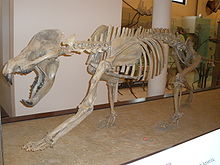Bear-dogs
| Amphicyonidae Temporal range: 46.2–1.8 Ma Middle Eocene - |
|
|---|---|
 |
|
| Skeleton of Amphicyon | |
| Scientific classification | |
| Kingdom: | Animalia |
| Phylum: | Chordata |
| Class: | Mammalia |
| Order: | Carnivora |
| Suborder: | Caniformia |
| Family: |
†Amphicyonidae Haeckel, 1886 |
| Subfamilies | |
|
|
Amphicyonidae is an extinct family of large terrestrial carnivorans belonging to the suborder Caniformia which inhabited North America, Europe, Asia, and Africa from the Middle Eocene subepoch to the epoch 46.2—1.8 Mya, existing for about 44.4 million years. Amphicyonids are often colloquially referred to as "bear-dogs", but are more closely related to true dogs (Canidae) than to bears (Ursidae).
The family was erected by Haeckel (1886) [also attributed to Trouessart 1885]. It was assigned to Carnivora by Sach and Heizmann (2001); to Arctoidea by Hunt (2001), Hunt (2002), and Hunt (2002); affirmed as Arctoidea by Zhai et al. (2003); affirmed to Arctoidea by Carroll (1988), Hunt (1998), and Wang et al. (2005); and to Caniformia by Morlo et al. (2007).
It is uncertain where Amphicyonids, often referred to as "bear dogs", originated. It was thought that they may have crossed from Europe to North America during the Miocene epoch, but recent research suggests a possible North American origin from the renamed Miacidae, Miacis cognitus and Miacis australis (now renamed as the genera Gustafsonia and respectively). As these are of North American origin, but appear to be early amphicyonids, it may be that amphicyonidae actually originates in North America.
...
Wikipedia
